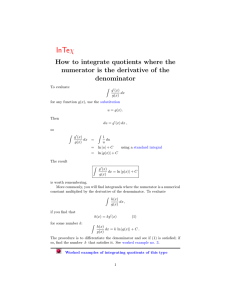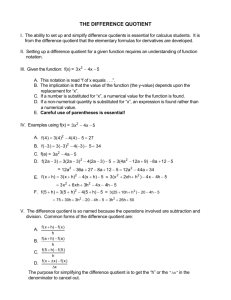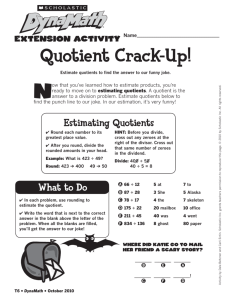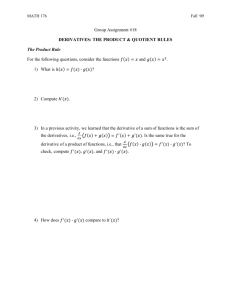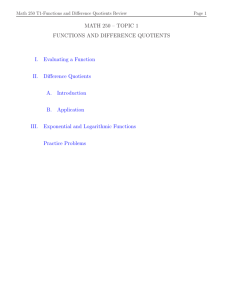Section 1.1 (cont.): Difference Quotients
advertisement
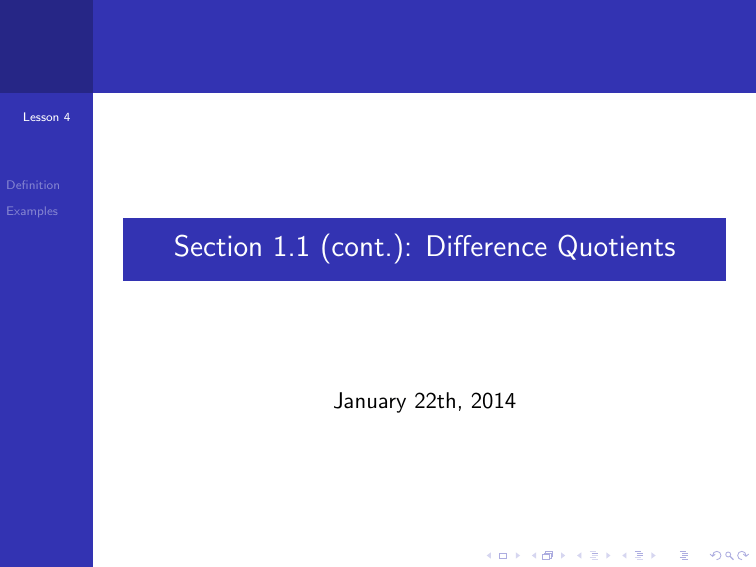
Lesson 4 Definition Examples Section 1.1 (cont.): Difference Quotients January 22th, 2014 Lesson 4 Definition A difference quotient is an expression of the form Examples f (x + h) − f (x) h for a function f (x). As we will see shortly, difference quotients are essential to the definition of the derivative of a function. The derivative of a function will be the main topic for this class. In this lesson we will focus on using algebra to simplify difference quotients Lesson 4 Definition Examples Consider the function f (x) = 3x + 5. Let’s compute the difference quotient of f . Remember the difference quotient of f (x) is just a fraction whose numerator is f (x + h) − f (x) and whose denominator is h. In this expression, h is a a separate variable, independent from x. First, let’s compute the numerator. (x + h) − f (x) = [3(x + h) + 5] − (3x + 5) = 3x + 3h + 5 − 3x − 5 = 3h Thus for the difference quotient, we have 3h f (x + h) − f (x) = =3 h h Lesson 4 Definition Examples As a general rule of thumb, you should always be able to cancel the h in the denominator of the difference quotient. If you can’t cancel the h in the denominator with an h in the numerator, most likely there has been an error in computing f (x + h) − f (x). Example Find the difference quotient of f . f (x) = 1 − 7x f (x + h) − f (x) 1 − 7(x + h) − (1 − 7x) = h h 1 − 7x − 7h − 1 + 7x = h −7h = = −7 h Lesson 4 Definition Examples f (x) = 3x 2 + 6x − 1 The idea here is the same as before, but the computation will be a little more complicated. First let’s compute f(x+h). f (x + h) = 3(x + h)2 + 6(x + h) − 1 = 3(x 2 + 2xh + h2 ) + 6(x + h) − 1 = 3x 2 + 6xh + 3h2 + 6x + 6h − 1 Notice the 3x 2 , the 6x, and the −1 will cancel with the terms from f (x). Therefore f (x + h) − f (x) = 6xh + 3h2 + 6h = h(6x + 3h + 6), and so f (x + h) − f (x) h(6x + 3h + 6) = = 6x + 3h + 6. h h Lesson 4 Definition Examples Let’s finish with one more example. Again, the idea will be the same, but the algebra will be a little more involved. f (x) = 1 x−1 1 − 1 f (x + h) − f (x) = x+h−1 x−1 h h To continue at this point, we must get a common denominator among the terms in the numerator. The easiest common denominator is just the product of the two denominators. 1 x+h−1 − h 1 x−1 = = x−1 (x−1)(x+h−1) − h x−1−(x+h−1) (x−1)(x+h−1) h x+h−1 (x−1)(x+h−1) Lesson 4 Definition Examples = x−1−x−h+1 (x−1)(x+h−1) h = −h (x−1)(x+h−1) h h = =− −1 (x−1)(x+h−1) h 1 (x − 1)(x + h − 1)
